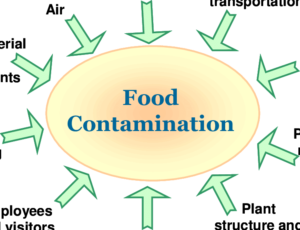Back to: Pre Vocational Studies JSS 1
Welcome to class!
In today’s class, we’re going to be talking about Food Contaminants. I trust you will enjoy the class!
Introduction
Food contaminants are substances that are unintentionally added to food. They can come from various sources, including the environment, agricultural practices, processing, and handling. Food contaminants can pose serious health risks if consumed.

Types of Food Contaminants
- Biological Contaminants: These are living organisms that can contaminate food, such as:
- Bacteria: Examples include Salmonella, E. coli, and Listeria. These bacteria can cause foodborne illnesses like food poisoning. Salmonella is a common foodborne illness that can be transmitted through contaminated poultry, eggs, and meat. E. coli is a bacteria that can cause severe abdominal cramps, diarrhea, and vomiting. Listeria is a bacteria that can cause serious illness, especially in pregnant women, newborns, the elderly, and people with weakened immune systems.
- Viruses: Examples include Hepatitis A and norovirus. These viruses can be transmitted through contaminated food and water. Hepatitis A is a viral infection that can cause inflammation of the liver. Norovirus is a highly contagious virus that can cause severe vomiting and diarrhea.
- Parasites: Examples include tapeworms and roundworms. These parasites can infect humans through contaminated meat or water. Tapeworms are flatworms that can live in the intestines. Roundworms are cylindrical worms that can infect the intestines or other organs.
- Fungi: Examples include mold and yeast. These fungi can produce toxins that can cause illness. Mold can produce mycotoxins, which can cause various health problems, including liver damage and cancer. Yeast can cause food spoilage and produce toxins that can be harmful if consumed.
- Chemical Contaminants: These are harmful substances that can enter food through various sources, such as:
- Pesticides: Chemical substances used to control pests in agriculture. Pesticide residues can remain on food, potentially posing health risks. Pesticides can be harmful to humans and animals if consumed in excessive amounts. They can cause a variety of health problems, including headaches, nausea, and neurological damage.
- Heavy metals: Naturally occurring elements like lead, mercury, and arsenic. These heavy metals can contaminate food through pollution or improper handling. Lead poisoning can cause a variety of health problems, including brain damage, kidney damage, and anemia. Mercury poisoning can cause neurological damage, kidney damage, and birth defects. Arsenic poisoning can cause skin problems, respiratory problems, and cancer.
- Cleaning agents: Chemical substances used to clean food processing equipment. Residues of cleaning agents can contaminate food if not properly rinsed. Cleaning agents can be harmful if consumed and can cause a variety of health problems, including nausea, vomiting, and diarrhea.
- Food additives: Substances intentionally added to food to improve its appearance, taste, or texture. Some food additives can be harmful if misused or consumed in excess. For example, excessive consumption of MSG can lead to headaches, nausea, and chest pain.
- Physical Contaminants: These are foreign objects that can accidentally enter food, such as:
- Glass shards: Fragments of glass that can break off from containers or processing equipment. Glass shards can cause cuts and other injuries if ingested.
- Metal fragments: Pieces of metal that can enter food from machinery or packaging. Metal fragments can cause cuts, choking, or other injuries.
- Stones or dirt: Foreign objects that can accidentally be introduced during food production or handling. Stones and dirt can cause choking or other injuries if ingested.
Sources of Food Contamination
- Agricultural Practices: The use of pesticides, fertilizers, and other chemicals can contaminate food. For example, the overuse of pesticides can lead to pesticide residue on fruits and vegetables.
- Processing and Handling: Improper handling, storage, or processing of food can lead to contamination. For example, food can become contaminated if it is not cooked to the proper temperature or if it is stored at the wrong temperature.
- Environmental Factors: Pollution, natural disasters, and other environmental factors can contribute to food contamination. For example, pollution can lead to the contamination of water and soil, which can in turn contaminate food.
Prevention of Food Contamination
- Proper Hygiene: Wash hands, surfaces, and utensils thoroughly before and after handling food.
- Safe Food Handling: Store food at the correct temperature and avoid cross-contamination.
- Choose Safe Foods: Select foods from reputable sources and check expiration dates.
- Cook Food Thoroughly: Cooking food to the proper temperature can kill harmful bacteria.
Examples of Food Contaminants
- Salmonella: A common foodborne illness caused by contaminated poultry, eggs, and meat. Salmonella can cause severe abdominal cramps, diarrhea, and vomiting.
- E. coli: A bacteria that can cause severe abdominal cramps, diarrhea, and vomiting. E. coli can be transmitted through contaminated meat, poultry, and produce.
- Lead poisoning: A serious health condition caused by exposure to lead, which can contaminate food and water. Lead poisoning can cause a variety of health problems, including brain damage, kidney damage, and anemia.
- Pesticide residue: Chemical substances that can remain on fruits and vegetables if not washed properly. Pesticide residue can cause a variety of health problems, including headaches, nausea, and neurological damage.
Summary
Food contaminants can pose serious health risks if consumed. By understanding the different types of food contaminants and taking steps to prevent contamination, you can help to ensure the safety of your food. It is important to be aware of food safety practices and to choose safe and high-quality food products.
Questions
- What are the common types of bacteria that can contaminate food?
- How can viruses be transmitted through food?
- What are the risks associated with parasitic infections?
We have come to the end of today’s class. I hope you enjoyed the class!
In the next class, we shall be discussing Harmful Substances that should not be consumed.
In case you require further assistance or have any questions, feel free to ask in the comment section below, and trust us to respond as soon as possible. See you in the next class!
